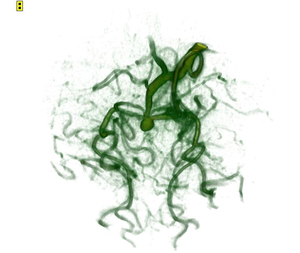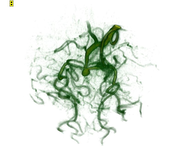Information
- Publication Type: Student Project
- Workgroup(s)/Project(s):
- Date: 2009
- Matrikelnummer: 0326997
- First Supervisor: Erald Vucini
Abstract
Traditional Direct Volume Raycasting (DVR) on the GPU is limited to uniform voxel grids stored as 3D textures. This approach is not optimal for sparse data sets or data sets with highly varying frequencies because it requires a trade-off between data structure size and the maximum reproducible frequency and it lacks implicit empty space skipping during raycasting. In this paper we present another approach, applying the Bounding Interval Hierarchy (BIH), a hierarchical spatial subdivision of elements traditionally used to accelerate surface raytracing, to volume raycasting on the GPU. Although connectivity information between voxels is lost and the texture filtering power of GPUs cannot be exploited, we show that it may be a viable alternative for DVR and that the approach is generic, allowing all sorts of renderable voxels (not-overlapping finite volume elements/primitives such as cuboids, ellipsoids and truncated Radial Basis Functions) for different tasks like rendering point sets as particle systems (e.g. using spherical voxels) and rendering volumes derived from traditional uniform grids (with implicit empty space skipping and the option for different levels of detail).Additional Files and Images
Weblinks
No further information available.BibTeX
@studentproject{Kinkelin_2009,
title = "GPU Volume Raycasting using Bounding Interval Hierarchies",
author = "Martin Kinkelin",
year = "2009",
abstract = "Traditional Direct Volume Raycasting (DVR) on the GPU is
limited to uniform voxel grids stored as 3D textures. This
approach is not optimal for sparse data sets or data sets
with highly varying frequencies because it requires a
trade-off between data structure size and the maximum
reproducible frequency and it lacks implicit empty space
skipping during raycasting. In this paper we present another
approach, applying the Bounding Interval Hierarchy (BIH), a
hierarchical spatial subdivision of elements traditionally
used to accelerate surface raytracing, to volume raycasting
on the GPU. Although connectivity information between voxels
is lost and the texture filtering power of GPUs cannot be
exploited, we show that it may be a viable alternative for
DVR and that the approach is generic, allowing all sorts of
renderable voxels (not-overlapping finite volume
elements/primitives such as cuboids, ellipsoids and
truncated Radial Basis Functions) for different tasks like
rendering point sets as particle systems (e.g. using
spherical voxels) and rendering volumes derived from
traditional uniform grids (with implicit empty space
skipping and the option for different levels of detail).",
URL = "https://www.cg.tuwien.ac.at/research/publications/2009/Kinkelin_2009/",
}


